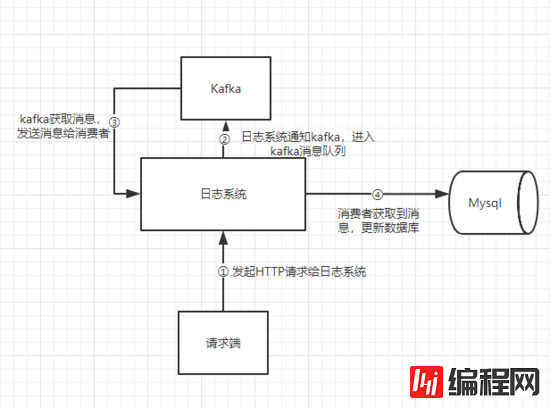这篇文章主要为大家展示了“KOA+egg.js如何集成kafka消息队列”,内容简而易懂,条理清晰,希望能够帮助大家解决疑惑,下面让小编带领大家一起研究并学习一下“KOA+egg.js如何集成kafka消息
这篇文章主要为大家展示了“KOA+egg.js如何集成kafka消息队列”,内容简而易懂,条理清晰,希望能够帮助大家解决疑惑,下面让小编带领大家一起研究并学习一下“KOA+egg.js如何集成kafka消息队列”这篇文章吧。
Egg.js : 基于KOA2的企业级框架
Kafka:高吞吐量的分布式发布订阅消息系统
本文章将集成egg + kafka + Mysql 的日志系统例子
系统要求:日志记录,通过kafka进行消息队列控制
思路图:

这里消费者和生产者都由日志系统提供
λ.1 环境准备
①Kafka
官网下载kafka后,解压
启动ZooKeeper:
bin/zookeeper-server-start.sh config/zookeeper.properties启动Kafka server
这里config/server.properties中将num.partitions=5,我们设置5个partitions
bin/kafka-server-start.sh config/server.properties② egg + mysql
根据脚手架搭建好egg,再多安装kafka-node,egg-mysql
mysql 用户名root 密码123456
λ.2 集成
1、根目录新建app.js,这个文件在每次项目加载时候都会运作
'use strict';
const kafka = require('kafka-node');
module.exports = app => {
app.beforeStart(async () => {
const ctx = app.createAnonymousContext();
const Producer = kafka.Producer;
const client = new kafka.KafkaClient({ kafkaHost: app.config.kafkaHost });
const producer = new Producer(client, app.config.producerConfig);
producer.on('error', function(err) {
console.error('ERROR: [Producer] ' + err);
});
app.producer = producer;
const consumer = new kafka.Consumer(client, app.config.consumerTopics, {
autoCommit: false,
});
consumer.on('message', async function(message) {
try {
await ctx.service.log.insert(JSON.parse(message.value));
consumer.commit(true, (err, data) => {
console.error('commit:', err, data);
});
} catch (error) {
console.error('ERROR: [GetMessage] ', message, error);
}
});
consumer.on('error', function(err) {
console.error('ERROR: [Consumer] ' + err);
});
});
};上述代码新建了生产者、消费者。
生产者新建后加载进app全局对象。我们将在请求时候生产消息。这里只是先新建实例
消费者获取消息将访问service层的insert方法(数据库插入数据)。
具体参数可以参考kafka-node官方api,往下看会有生产者和消费者的配置参数。
2、controller · log.js
这里获取到了producer,并传往service层
'use strict';
const Controller = require('egg').Controller;
class LoGController extends Controller {
async notice() {
const producer = this.ctx.app.producer;
const Response = new this.ctx.app.Response();
const requestBody = this.ctx.request.body;
const backInfo = await this.ctx.service.log.send(producer, requestBody);
this.ctx.body = Response.success(backInfo);
}
}
module.exports = LogController;3、service · log.js
这里有一个send方法,这里调用了producer.send ,进行生产者生产
insert方法则是数据库插入数据
'use strict';
const Service = require('egg').Service;
const uuidv1 = require('uuid/v1');
class LogService extends Service {
async send(producer, params) {
const payloads = [
{
topic: this.ctx.app.config.topic,
messages: JSON.stringify(params),
},
];
producer.send(payloads, function(err, data) {
console.log('send : ', data);
});
return 'success';
}
async insert(message) {
try {
const logDB = this.ctx.app.mysql.get('log');
const ip = this.ctx.ip;
const Logs = this.ctx.model.Log.build({
id: uuidv1(),
type: message.type || '',
level: message.level || 0,
operator: message.operator || '',
content: message.content || '',
ip,
user_agent: message.user_agent || '',
error_stack: message.error_stack || '',
url: message.url || '',
request: message.request || '',
response: message.response || '',
created_at: new Date(),
updated_at: new Date(),
});
const result = await logDB.insert('logs', Logs.dataValues);
if (result.affectedRows === 1) {
console.log(`SUCEESS: [Insert ${message.type}]`);
} else console.error('ERROR: [Insert DB] ', result);
} catch (error) {
console.error('ERROR: [Insert] ', message, error);
}
}
}
module.exports = LogService;4、config · config.default.js
一些上述代码用到的配置参数具体在这里,注这里开了5个partition。
'use strict';
module.exports = appInfo => {
const config = (exports = {});
const topic = 'logAction_p5';
// add your config here
config.middleware = [];
config.security = {
csrf: {
enable: false,
},
};
// mysql database configuration
config.mysql = {
clients: {
basic: {
host: 'localhost',
port: '3306',
user: 'root',
passWord: '123456',
database: 'merchants_basic',
},
log: {
host: 'localhost',
port: '3306',
user: 'root',
password: '123456',
database: 'merchants_log',
},
},
default: {},
app: true,
agent: false,
};
// sequelize config
config.sequelize = {
dialect: 'mysql',
database: 'merchants_log',
host: 'localhost',
port: '3306',
username: 'root',
password: '123456',
dialectOptions: {
requestTimeout: 999999,
},
pool: {
acquire: 999999,
},
};
// kafka config
config.kafkaHost = 'localhost:9092';
config.topic = topic;
config.producerConfig = {
// Partitioner type (default = 0, random = 1, cyclic = 2, keyed = 3, custom = 4), default 0
partitionerType: 1,
};
config.consumerTopics = [
{ topic, partition: 0 },
{ topic, partition: 1 },
{ topic, partition: 2 },
{ topic, partition: 3 },
{ topic, partition: 4 },
];
return config;
};5、实体类:
mode · log.js
这里使用了 Sequelize
'use strict';
module.exports = app => {
const { STRING, INTEGER, DATE, TEXT } = app.Sequelize;
const Log = app.model.define('log', {
id: { type: STRING(36), primaryKey: true },
type: STRING(100),
level: INTEGER,
operator: STRING(50),
content: TEXT,
ip: STRING(36),
user_agent: STRING(150),
error_stack: TEXT,
url: STRING(255),
request: TEXT,
response: TEXT,
created_at: DATE,
updated_at: DATE,
});
return Log;
};import requests
from multiprocessing import Pool
from threading import Thread
from multiprocessing import Process
def loop():
t = 1000
while t:
url = "Http://localhost:7001/log/notice"
payload = "{\n\t\"type\": \"ERROR\",\n\t\"level\": 1,\n\t\"content\": \"URL send ERROR\",\n\t\"operator\": \"Knove\"\n}"
headers = {
'Content-Type': "application/json",
'Cache-Control': "no-cache"
}
response = requests.request("POST", url, data=payload, headers=headers)
print(response.text)
if __name__ == '__main__':
for i in range(10):
t = Thread(target=loop)
t.start()7、建表语句:
SET NAMES utf8mb4;
SET FOREIGN_KEY_CHECKS = 0;
-- ----------------------------
-- Table structure for logs
-- ----------------------------
DROP TABLE IF EXISTS `logs`;
CREATE TABLE `logs` (
`id` varchar(36) CHARACTER SET utf8mb4 COLLATE utf8mb4_bin NOT NULL,
`type` varchar(100) CHARACTER SET utf8mb4 COLLATE utf8mb4_bin NOT NULL COMMENT '日志类型',
`level` int(11) NULL DEFAULT NULL COMMENT '优先等级(数字越高,优先级越高)',
`operator` varchar(50) CHARACTER SET utf8mb4 COLLATE utf8mb4_bin NULL DEFAULT NULL COMMENT '操作人',
`content` text CHARACTER SET utf8mb4 COLLATE utf8mb4_bin NULL COMMENT '日志信息',
`ip` varchar(36) CHARACTER SET utf8mb4 COLLATE utf8mb4_bin NULL DEFAULT NULL COMMENT 'IP\r\nIP',
`user_agent` varchar(150) CHARACTER SET utf8mb4 COLLATE utf8mb4_bin NULL DEFAULT NULL COMMENT '当前用户代理信息',
`error_stack` text CHARACTER SET utf8mb4 COLLATE utf8mb4_bin NULL COMMENT '错误堆栈',
`url` varchar(255) CHARACTER SET utf8mb4 COLLATE utf8mb4_bin NULL DEFAULT NULL COMMENT '当前URL',
`request` text CHARACTER SET utf8mb4 COLLATE utf8mb4_bin NULL COMMENT '请求对象',
`response` text CHARACTER SET utf8mb4 COLLATE utf8mb4_bin NULL COMMENT '响应对象',
`created_at` datetime(0) NULL DEFAULT NULL COMMENT '创建时间',
`updated_at` datetime(0) NULL DEFAULT NULL COMMENT '更新时间',
PRIMARY KEY (`id`) USING BTREE
) ENGINE = InnoDB CHARACTER SET = utf8mb4 COLLATE = utf8mb4_bin ROW_FORMAT = Dynamic;
SET FOREIGN_KEY_CHECKS = 1;以上是“KOA+egg.js如何集成kafka消息队列”这篇文章的所有内容,感谢各位的阅读!相信大家都有了一定的了解,希望分享的内容对大家有所帮助,如果还想学习更多知识,欢迎关注编程网node.js频道!
--结束END--
本文标题: KOA+egg.js如何集成kafka消息队列
本文链接: https://lsjlt.com/news/75498.html(转载时请注明来源链接)
有问题或投稿请发送至: 邮箱/279061341@qq.com QQ/279061341
2022-06-04
2022-06-04
2022-06-04
2022-06-04
2022-06-04
2022-06-04
2022-06-04
2022-06-04
2022-06-04
2022-06-04
回答
回答
回答
回答
回答
回答
回答
回答
回答
回答
0